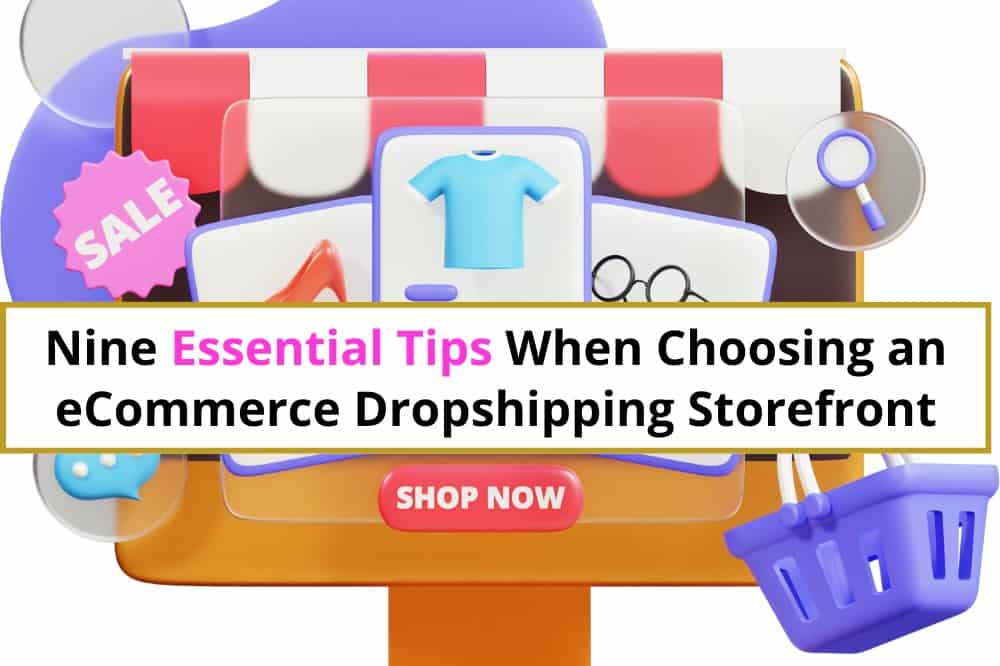Dropshipping is an excellent online business to run, but of course, you’ll have to choose the right e-commerce platform that specifically tailors to dropshippers.
Here are nine essential tips to help you choose the right e-commerce platform for your new dropshipping business…
 This post may contain affiliate links. Please see my disclaimer for more information.
This post may contain affiliate links. Please see my disclaimer for more information.
1. Understand Your Business Needs
Before diving into the plethora of e-commerce platforms, it’s crucial to define your business needs clearly.
Consider factors such as the type of products you plan to sell, your target audience, and the scale of your operations. Understanding these parameters will help you narrow down platforms that cater to your specific requirements.
Related Reading: How To Start a Dropshipping Business in 9 Simple Steps
2. Evaluate Platform Features
Different e-commerce platforms offer various features.
Essential features to look for include:
Integration with Suppliers: Ensure the platform seamlessly integrates with your chosen suppliers and allows for easy import of products.
Inventory Management: Look for robust inventory management tools that update stock levels automatically.
Order Processing: The platform should facilitate smooth order processing, from placement to shipment tracking.
Customization: Choose a platform that allows you to customize your store’s design to match your brand identity.
3. Consider User Experience
A user-friendly interface is vital for both you and your customers.
The platform should be easy to navigate, with intuitive controls for setting up and managing your store.
For customers, a seamless shopping experience with a straightforward checkout process can significantly enhance satisfaction and boost sales.
Recommendation: AutoDS The #1 Automated Tool for Your Dropshipping Store
4. Assess Pricing Structures
Pricing is a critical factor in choosing an e-commerce platform.
Evaluate the costs involved, including subscription fees, transaction fees, and any additional charges for plugins or extensions. Compare these costs with the features offered to ensure you get value for your money.
It’s also wise to consider platforms that offer scalable pricing plans, allowing your business to grow without incurring exorbitant costs.
5. Look for Marketing Tools
Effective marketing is crucial for driving traffic and sales.
Opt for platforms that offer built-in marketing tools such as SEO optimization, email marketing, social media integration, and promotional features.
These tools can help you reach a broader audience and effectively promote your products.
6. Check for Mobile Compatibility
With a significant portion of online shopping done via mobile devices, ensuring your e-commerce platform is mobile-friendly is imperative.
The platform should offer responsive design options, allowing your store to function smoothly on smartphones and tablets, and providing a consistent shopping experience across all devices.
7. Review Customer Support
Reliable customer support can make a significant difference, especially when facing technical issues or needing assistance with platform features.
Look for platforms that offer comprehensive support options, including live chat, email, phone support, and extensive documentation or knowledge bases.
8. Analyze Security Features
Security is paramount in e-commerce, as you’ll be handling sensitive customer information.
Ensure the platform provides robust security measures, including SSL certification, secure payment gateways, and compliance with data protection regulations. A secure platform builds customer trust and protects your business from potential threats.
Recommendation: AutoDS The #1 Automated Tool for Your Dropshipping Store
9. Read Reviews and Seek Recommendations
Researching reviews and seeking recommendations from other dropshippers can provide valuable insights. Look for reviews on third-party websites to get unbiased opinions about the platform’s performance, reliability, and customer service. Joining dropshipping communities or forums can also help you gather recommendations and learn from the experiences of others.
10. Test Before Committing
Many e-commerce platforms offer free trials or demo versions.
Take advantage of these trials to test the platform’s features, usability, and compatibility with your business needs. This hands-on experience can help you make a well-informed decision before making a financial commitment.
Conclusion
Choosing the right e-commerce platform for your dropshipping business is a critical step towards success.
By carefully evaluating your business needs, platform features, pricing, user experience, and security, you can select a platform that supports your growth and enhances your operational efficiency.
Take your time to research, test, and compare options to ensure you make the best choice for your e-commerce venture.
Learn more about starting your own dropshipping business and how to automate it so you can earn passive income.
Hi, I’m Claire Bullerwell
I’ve ran dozens of home-based businesses, both offline and online, since my early twenties. I started this blog to share all my wealth of knowledge and experience to help women just like you; to find your dream home business and to live your best life.
Follow me and let’s get acquainted…



